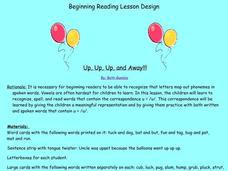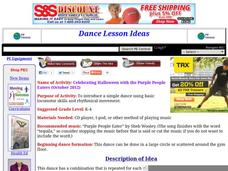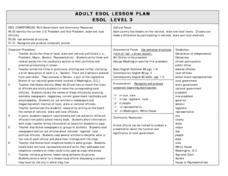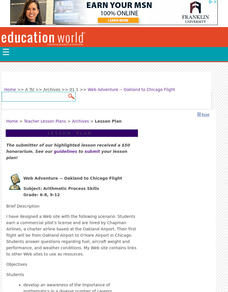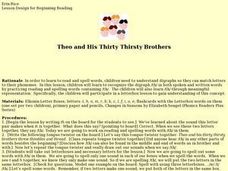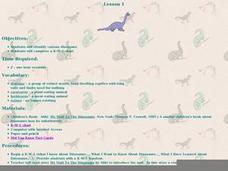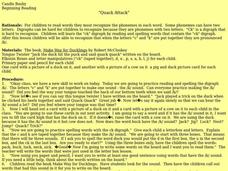Curated OER
Up, Up and Away
Students recognize the short vowel u in written and spoken language. Through matching and listening activities, they discriminate the vowel sound /u/ from other phonemes. Students identify the phoneme and letter in words and pictures.
Curated OER
Copycat, Copycat!
Students observe that sometimes the letter "c" is a copycat letter and sometimes acts like a "k" or an "s" like in the words "cat" and "race". They use Elkonin letter boxes and letters to spell words as they are called out by the...
Curated OER
/o/... I can't stop yawning!
Students investigate the phoneme, a meaningful representation, and the letter symbol for /o/ (short o). This lesson helps students recognize the /o/ in spoken words and begin to spell words with the assistance of letter boxes. Students...
Curated OER
Name Game
Student select a name card from the envelope and class will then sound out the name of the child on the card. They then will spell out the child's name chanting "Give me an A...", "Give me an N...", etc. The teacher then says, "What does...
Curated OER
I Am Tired
First graders recognize the short vowel o in written and spoken language. Through listening and matching activities, they discriminate the vowel sound /o/ from other phonemes. Students associate the phoneme with its letter representation...
Curated OER
Yummy in My Tummy
Students explore phonemes in spoken words. They discuss the correspondence u=/u/. Students identify a meaningful representation for the phoneme and practice identifying /u/ in both written and spoken words. Students learn a tongue...
Curated OER
Celebrating Halloween With the Purple People Eaters
Get youngsters moving by teaching them some basic dance moves. This dance can be done in a circle, a line, or scattered around the gym. There are four movement combinations that are taught to the song "Purple People Eater" by Sheb...
Curated OER
Icky Fingers
Students are introduced to digraphs so they can match letters to their phonemes. They recognize the short vowel i=/i/ in both spoken and written words by practicing reading and spelling words containing /i/. Elkonin Letter Boxes are...
Curated OER
Who Are Your Local Officials?
Young scholars identify the names and positions held by local public officials. In pairs, students research the requirements and duties needed to hold office. A brief presentation of their research will include the names and positions...
Curated OER
Web Adventure -- Oakland to Chicago Flight
Students develop an awareness of mathematics in a diverse number of careers, then describe three duties of a pilot that require mathematical skills. They increase understanding of interpreting data relationships presented in table format.
Curated OER
Basic Waltz Steps
Learn the five basic waltz steps: box step, under arm turn, walt left box or waltz right box, hesitation step, and progressive waltz step. Teach a little about the history of the waltz and the countries from which it came: Germany and...
Curated OER
Printing Practice Letter P
In this printing worksheet, students trace 4 uppercase letter P's. The first box provides arrows that guide students in tracing the letter.
Curated OER
Alliteration
In this alliteration worksheet, 4th graders write alliterations with their first names, find rhyming patterns in poems, and more. Students complete 4 activities.
Curated OER
Reading in Preschool
Students read along with their parents to promote their own reading and fluency. In this reading lesson plan, students look at picture books and follow along with their finger.
Curated OER
Sh! Sh! Stop that Noise!
Students practice reading, writing, and spelling words that contain the /sh/ digraph. Students participate in a chant using /sh/ digraph words. They then use Elkonin boxes to spell words containing the digraph. They complete a worksheet...
Curated OER
"OU" O U Hurt Me!
Pupils explore the digraph ou=/ow/ in written and spoken words. They practice writing words with the ou=/ow/ digraph. Students match phonemes in words they hear. Pupils read The Napping House and identify words with the ou=/ow/ digraph.
Curated OER
Theo and His Thirty Thirsty Brothers
Students recognize the digraph /th/ in both spoken and written words. They read and spell words containing /th/ digraph. They read "Changes in Seasons" by Eizabeth Sengel and make a list of the words containing /th/ digraph.
Curated OER
Identifying Dinosaurs
Students investigate basic information about dinosaurs. They listen to the book, "My Visit To the Dinosaurs," explore various websites, take an online quiz, and play an online dinosaur game.
Curated OER
Quack Attack
Students identify phonemes in words. They read and spell words that contain the /ck/ digraph. Students read the book Make Way for Ducklings. They practice reading and identifying words with the ck digraph while reading the story.
Curated OER
Social Life in the 1950's and Domestic Politics and Policy
Eleventh graders examine the cultural mood and politics of the 1950's in the United States. They read a section of their text and take notes, view a clip of the movie "Pleasantville" and discuss societal roles in the 1950's, and listen...
Curated OER
Using Numbers to Teach The Major Scale
Students study the numbers to the diatonic major scale using C note as a basis in this standards-based 45 minute activity. Emphasis is placed on singing correct pitch, rhythmic accuracy, and proper breath control.
Curated OER
Big, Bad, "B" and "D"
Students practice discerning between the letters D and B. Through hands on and listening activities, they recognize the difference between the commonly confused letters B and D. They practice writing both letters and correcting common...
Curated OER
You can call me.........Speedy Gonzalez!
Students practice their decoding skills to increase reading fluency. They use timed reading to observe the rate at which they read. They work in small groups to read a book in a time situation.
Curated OER
Music in the Common Schools
Students sing songs from the common schools era and compare music from the common schools era and today. In this music lesson plan, students look at pictures, fill out Venn Diagrams, and listen to music.
